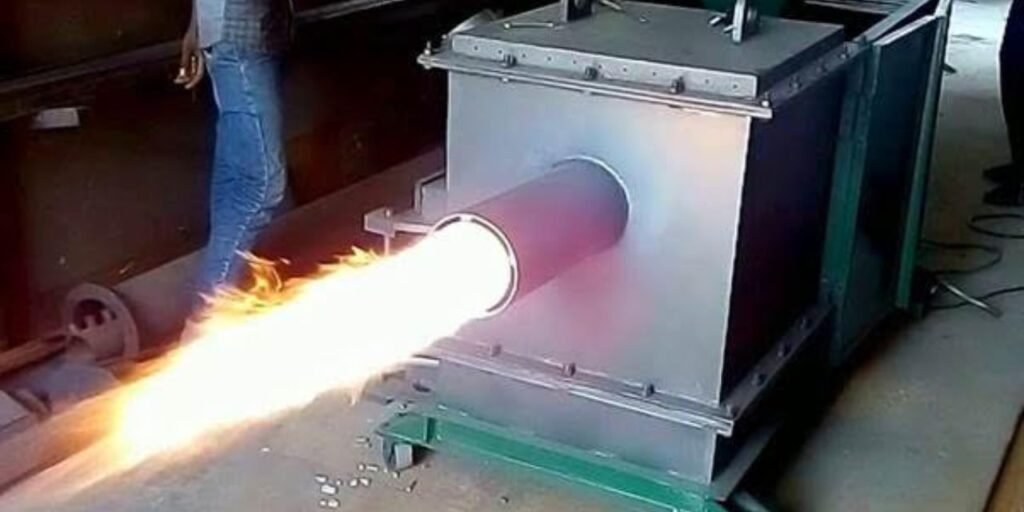
Introduction
The industrial burner market has experienced significant growth in recent years, driven by the increasing demand for energy-efficient systems, rising industrial production, and the push for reducing emissions. Industrial burners are critical components in a variety of industries, including manufacturing, power generation, and process industries. These devices are responsible for delivering controlled combustion in various processes, ensuring efficient heat production, and optimizing energy use. This article explores the current state of the industrial burner market, key drivers of growth, technological advancements, and the emerging trends shaping its future.
Market Overview
Industrial burners are combustion devices used to burn fuels such as natural gas, oil, coal, and biomass in industrial settings. These burners are found in a wide range of applications, from heating in manufacturing processes to generating electricity in power plants. As industries move towards more energy-efficient and environmentally friendly practices, the demand for high-efficiency burners is growing.
The industrial burner market is estimated to increase from US$ 6.4 Bn in 2024 to US$ 9.18 Bn by 2031. The market is projected to record a CAGR of 5.2% during the period from 2024 to 2031 as per report published by Persistence Market Research. The market for industrial burners is expected to grow due to industrialization, mining, and petrochemical activities. Leading companies are also investing in burner capabilities to reduce pollution and carbon footprints. According to the U.S. This growth is driven by several factors, including the increased focus on energy efficiency, the push for greener technologies, and the need for reliable, high-performance burners in industrial applications.
Key Drivers of Market Growth
- Rising Demand for Energy Efficiency: The need for energy efficiency is one of the primary drivers in the industrial burner market. Energy costs represent a significant portion of operational expenses for many industries, and optimizing burner efficiency can lead to substantial cost savings. Modern industrial burners are designed to minimize energy consumption while maximizing combustion efficiency. This trend is particularly evident in industries such as cement production, chemical manufacturing, and metal processing, where high-temperature processes are critical.
- Strict Environmental Regulations: With growing concerns about environmental pollution and climate change, governments worldwide are implementing stringent regulations to reduce greenhouse gas (GHG) emissions. Industrial burners are integral to achieving these emission reduction goals. The market is witnessing a surge in the adoption of low-emission burners, which are designed to minimize NOx, CO2, and particulate matter emissions. These burners use advanced combustion technologies to ensure cleaner combustion processes, contributing to the decarbonization goals of various industries.
- Growth of Industrial Production: As global manufacturing output increases, the demand for energy-efficient combustion solutions grows. Industries such as automotive, chemicals, food processing, and steel are major consumers of industrial burners. As these sectors expand, they require increasingly sophisticated burner systems to meet production needs while reducing energy consumption and emissions. For instance, the rise in demand for steel and cement production, which relies heavily on combustion processes, is expected to continue driving market growth.
- Technological Advancements: The industrial burner market is undergoing a transformation driven by technological innovations. Modern burners now feature advanced control systems that optimize fuel consumption, improve combustion stability, and monitor emissions in real-time. The integration of smart sensors, automation, and Internet of Things (IoT) technology is improving the efficiency and monitoring capabilities of industrial burners. These advancements are enhancing the overall performance of burners and enabling industries to meet their sustainability targets.
- Shift Toward Renewable and Alternative Fuels: There is a growing trend toward using renewable and alternative fuels in industrial burners. Biomass, hydrogen, and synthetic fuels are becoming viable options in sectors that traditionally relied on fossil fuels. The transition to these renewable energy sources is not only driven by environmental considerations but also by the availability of government incentives and subsidies that encourage cleaner technologies. The development of multi-fuel burners capable of handling a variety of fuels is fueling this shift and expanding the market.
Technological Innovations in Industrial Burners
- Low-NOx Burners: Nitrogen oxides (NOx) are a key pollutant emitted during combustion processes, contributing to air pollution and acid rain. In response to stringent regulatory standards, manufacturers are developing low-NOx burners. These burners use advanced combustion techniques, such as staged combustion or flue gas recirculation, to significantly reduce NOx emissions. The introduction of low-NOx burners is becoming a critical trend, particularly in sectors such as power generation and cement manufacturing.
- High-Efficiency Burners: Efficiency remains a major focus of industrial burner innovation. Advanced burners are now capable of operating at higher thermal efficiency levels, ensuring that more energy is extracted from the fuel, reducing waste and lowering operational costs. These high-efficiency burners often feature precision combustion control systems, which help achieve optimal fuel-to-air ratios, resulting in better heat recovery and lower energy consumption.
- Smart Burners: The incorporation of smart technologies is transforming the industrial burner landscape. Smart burners use IoT sensors to continuously monitor and control combustion parameters such as temperature, fuel flow, and pressure. These sensors allow for real-time data analysis, which helps improve burner performance, reduce maintenance costs, and optimize fuel consumption. Additionally, smart burners can be integrated with centralized control systems, enabling remote monitoring and diagnostics, reducing the need for on-site interventions.
- Multifuel Burners: Multifuel burners are becoming increasingly popular due to their flexibility in handling different types of fuels, including natural gas, coal, biomass, and even waste-derived fuels. This adaptability is crucial as industries seek to diversify their energy sources and reduce reliance on a single fuel type. Multifuel burners also offer greater operational flexibility, as they can adjust to changes in fuel availability or pricing, making them a cost-effective option in fluctuating market conditions
Market Dynamics
- Regional Insights: The industrial burner market exhibits strong regional variations based on industrial activity, regulatory frameworks, and energy availability. North America, particularly the United States, is a major market for industrial burners, driven by a strong manufacturing base and regulatory pressure to reduce emissions. Europe is also a key region for industrial burner adoption, with countries like Germany and the UK leading in the implementation of low-emission burners and renewable fuel adoption.
The Asia-Pacific region is expected to witness significant growth, particularly in emerging economies such as China and India. Rapid industrialization, growing manufacturing sectors, and increasing energy consumption are contributing to the rising demand for industrial burners in this region. Governments in these countries are also implementing stricter environmental regulations, further boosting the market for cleaner-burning technologies.
- Competitive Landscape: The industrial burner market is highly competitive, with numerous global and regional players vying for market share. Some of the key manufacturers in the market include Honeywell International, Siemens AG, John Zink Hamworthy Combustion, and ArcelorMittal, among others. These companies are investing heavily in research and development to innovate and offer high performance, environmentally friendly burner solutions. Strategic partnerships, mergers, and acquisitions are common as companies seek to expand their product portfolios and enhance their competitive edge.
Emerging Trends in the Industrial Burner Market
- Integration of Automation and AI: Automation is playing a significant role in the evolution of industrial burners. The integration of artificial intelligence (AI) in burner systems is helping optimize combustion processes by analyzing real-time data and making adjustments automatically. This ensures consistent performance and improves the efficiency of burner operations. AI-powered systems can also predict maintenance needs, reducing downtime and extending the lifespan of burners.
- Carbon Capture and Storage (CCS) Technologies: As industries seek to reduce their carbon footprint, the integration of carbon capture and storage (CCS) technologies with industrial burners is becoming more prevalent. CCS allows for the capture of CO2 emissions generated during combustion processes, preventing them from being released into the atmosphere. The development of CCS-compatible burners is gaining traction, particularly in industries with high emissions, such as cement and steel manufacturing.
- Circular Economy and Waste-to-Energy Solutions: The growing emphasis on sustainability is encouraging the development of waste-to-energy solutions. Industrial burners are increasingly being used to convert waste materials, including municipal solid waste and agricultural residues, into energy. These waste-to-energy systems are part of the broader circular economy trend, where waste is repurposed to generate energy, reducing landfill use and reliance on fossil fuels.
Challenges in the Industrial Burner Market
Despite the promising growth prospects, the industrial burner market faces several challenges. The high initial cost of advanced burners, particularly low-emission models, can be a barrier to adoption for some industries. Additionally, the complexity of integrating new technologies with existing infrastructure may require significant investment in training and maintenance. Furthermore, fluctuating fuel prices and regulatory changes can impact the market’s stability.
Future Outlook
The future of the industrial burner market is bright, with increasing focus on efficiency, sustainability, and innovation. As industries seek to meet environmental regulations and reduce energy costs, the demand for advanced burners will continue to grow. The adoption of smart technologies, multi-fuel capabilities, and low emission burners will drive the market towards a more energy-efficient and sustainable future.
Conclusion
In conclusion, the industrial burner market is evolving rapidly, driven by technological advancements, regulatory pressures, and the growing need for energy-efficient and sustainable solutions. As industries across the globe strive to meet their environmental goals, the demand for advanced combustion technologies will continue to rise. The market is poised for significant growth, offering opportunities for innovation, increased efficiency, and a cleaner, more sustainable industrial landscape.
